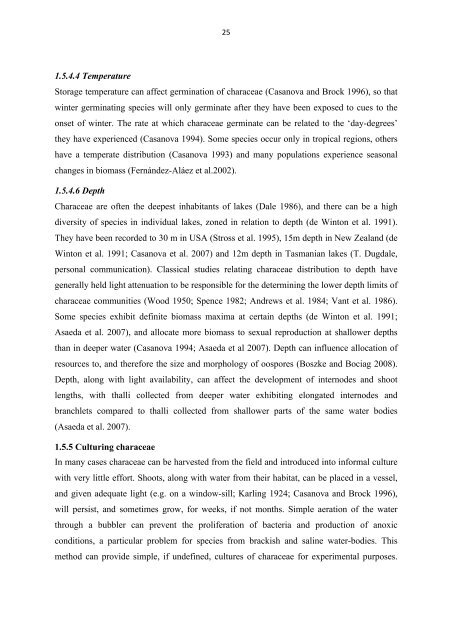Chapter 1: The Characeae Plant
Chapter 1: The Characeae Plant
Chapter 1: The Characeae Plant
Create successful ePaper yourself
Turn your PDF publications into a flip-book with our unique Google optimized e-Paper software.
25 <br />
1.5.4.4 Temperature<br />
Storage temperature can affect germination of characeae (Casanova and Brock 1996), so that<br />
winter germinating species will only germinate after they have been exposed to cues to the<br />
onset of winter. <strong>The</strong> rate at which characeae germinate can be related to the ‘day-degrees’<br />
they have experienced (Casanova 1994). Some species occur only in tropical regions, others<br />
have a temperate distribution (Casanova 1993) and many populations experience seasonal<br />
changes in biomass (Fernández-Aláez et al.2002).<br />
1.5.4.6 Depth<br />
<strong>Characeae</strong> are often the deepest inhabitants of lakes (Dale 1986), and there can be a high<br />
diversity of species in individual lakes, zoned in relation to depth (de Winton et al. 1991).<br />
<strong>The</strong>y have been recorded to 30 m in USA (Stross et al. 1995), 15m depth in New Zealand (de<br />
Winton et al. 1991; Casanova et al. 2007) and 12m depth in Tasmanian lakes (T. Dugdale,<br />
personal communication). Classical studies relating characeae distribution to depth have<br />
generally held light attenuation to be responsible for the determining the lower depth limits of<br />
characeae communities (Wood 1950; Spence 1982; Andrews et al. 1984; Vant et al. 1986).<br />
Some species exhibit definite biomass maxima at certain depths (de Winton et al. 1991;<br />
Asaeda et al. 2007), and allocate more biomass to sexual reproduction at shallower depths<br />
than in deeper water (Casanova 1994; Asaeda et al 2007). Depth can influence allocation of<br />
resources to, and therefore the size and morphology of oospores (Boszke and Bociag 2008).<br />
Depth, along with light availability, can affect the development of internodes and shoot<br />
lengths, with thalli collected from deeper water exhibiting elongated internodes and<br />
branchlets compared to thalli collected from shallower parts of the same water bodies<br />
(Asaeda et al. 2007).<br />
1.5.5 Culturing characeae<br />
In many cases characeae can be harvested from the field and introduced into informal culture<br />
with very little effort. Shoots, along with water from their habitat, can be placed in a vessel,<br />
and given adequate light (e.g. on a window-sill; Karling 1924; Casanova and Brock 1996),<br />
will persist, and sometimes grow, for weeks, if not months. Simple aeration of the water<br />
through a bubbler can prevent the proliferation of bacteria and production of anoxic<br />
conditions, a particular problem for species from brackish and saline water-bodies. This<br />
method can provide simple, if undefined, cultures of characeae for experimental purposes.
















